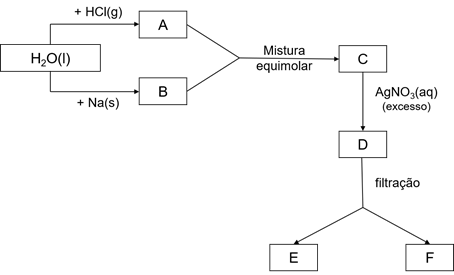A tabela apresenta uma estimativa da evolução da população brasileira por faixa etária, em milhões de pessoas, para 2020, 2030 e 2045.
Ano 2020 2030 2045

Com base na tabela, o valor que mais se aproxima da média dos percentuais da população brasileira na faixa etária até 14 anos, nos anos de 2020, 2030 e 2045, é
Questões relacionadas
- Geografia - Fundamental | 4.01 Regionalização da América
O desenho reflete uma situação de polaridade entre os Hemisférios Norte e Sul. Considerando a América Anglo Saxônica ao norte e América Latina ao sul, identifica-se no desenho a forma tradicional da
- Matemática | 3.4 Modular
As raízes da equação | x |2 + | x | – 6 = 0
- Química | 1.6 Reações Inorgânicas
O esquema a seguir representa uma sequência reacional praticada por um aluno de química em uma aula prática na universidade. O aluno observou que produção do composto B formava como subproduto uma substância gasosa, que a solução C apresentava pH neutro e que o composto E era um sólido precipitado.

Após a análise das observações feitas pelo aluno é possível inferir que o meio F é
- Geografia | 5.1 População
(UEL) Considerando que as taxas de natalidade, mortalidade, imigração e emigração são fatores responsáveis pela densidade populacional, analise o gráfico a seguir.
_(9).png)
Com base na análise do gráfico, considere as afirmativas a seguir.
I. No período entre t0 e t1, a soma das taxas de natalidade e emigração é maior que a soma das taxas de natalidade e imigração, enquanto que no período entre t1 e t2, a soma das taxas de mortalidade e emigração é menor que a soma das taxas de mortalidade e imigração.
II. No período entre t0 e t1, a soma das taxas de mortalidade e emigração é menor que a soma das taxas de natalidade e imigração, enquanto que no período entre t1 e t2, a soma das taxas de natalidade e imigração é menor que a soma das taxas de mortalidade e emigração.
III. No período entre t0 e t1, a soma das taxas de mortalidade e imigração é maior que a soma das taxas de mortalidade e emigração, enquanto que no período entre t1 e t2, a soma das taxas de natalidade e imigração é menor que a soma das taxas de natalidade e emigração.
IV. No período entre t0 e t1, a soma das taxas de natalidade e imigração é maior que a soma das taxas de natalidade e emigração, enquanto que no período entre t1 e t2, a soma das taxas de mortalidade e emigração é maior que a soma das taxas de mortalidade e imigração.
Assinale a alternativa correta.
- Língua Espanhola | 1.4 Estratégias de Leitura
Dejad a la gente correr
No habrá maratón en los próximos meses en la que los corredores no sientan la mezcla de temor y respeto por las víctimas que se desprende, inevitablemente, del atentado terrorista perpetrado en Boston el 15 de abril. Es un acto casi reflejo de inquietud, de pérdida de cierta inocencia en un evento convocado para unir a personas de procedencias muy distintas, sin importar más circunstancias, ideologías o credos.
El sábado por la noche, antes de la primera maratón de Cisjordania, los organizadores y participantes de esta se reunieron en Belén en una vigilia en la que, con velas, homenajearon a las víctimas de la masacre orquestada por los hermanos Tsarnaev, a los tres fallecidos y a los muchos heridos. “Palestina: solidaridad con las víctimas de la maratón”, se leía en sus carteles. “Toda la gente tiene el derecho a correr”, decían.
La de Belén era una maratón cargada de significado político. Organizada por el grupo independiente Right to Movement (Derecho al Movimiento), lucía como lema una breve cita de la Declaración Universal de los Derechos Humanos: “Toda persona tiene derecho a circular libremente”. Los agentes de policía palestinos habían redoblado la seguridad, en una medida más de puro acto reflejo que otra cosa.
Muchas son las cargas del pueblo palestino, a nivel de gobernanza interna y por imposiciones en Israel, pero un ataque terrorista a los corredores no era realmente una posibilidad. Finalmente participaron con total normalidad 650 corredores, de 28 países. El 70% eran palestinos. Necesariamente, la maratón discurrió en varios tramos frente al muro erigido por Israel, y atravesó dos campos de refugiados.
ALANDETE, D. Disponível em: http://blogs.elpais.com. Acesso em: 22 abr. 2013 (adaptado).
No texto são abordadas as circunstâncias em que aconteceu a primeira maratona realizada na Cisjordânia (Palestina). Os envolvidos nessa maratona propuseram um lema e confeccionaram faixas nas quais reivindicavam a